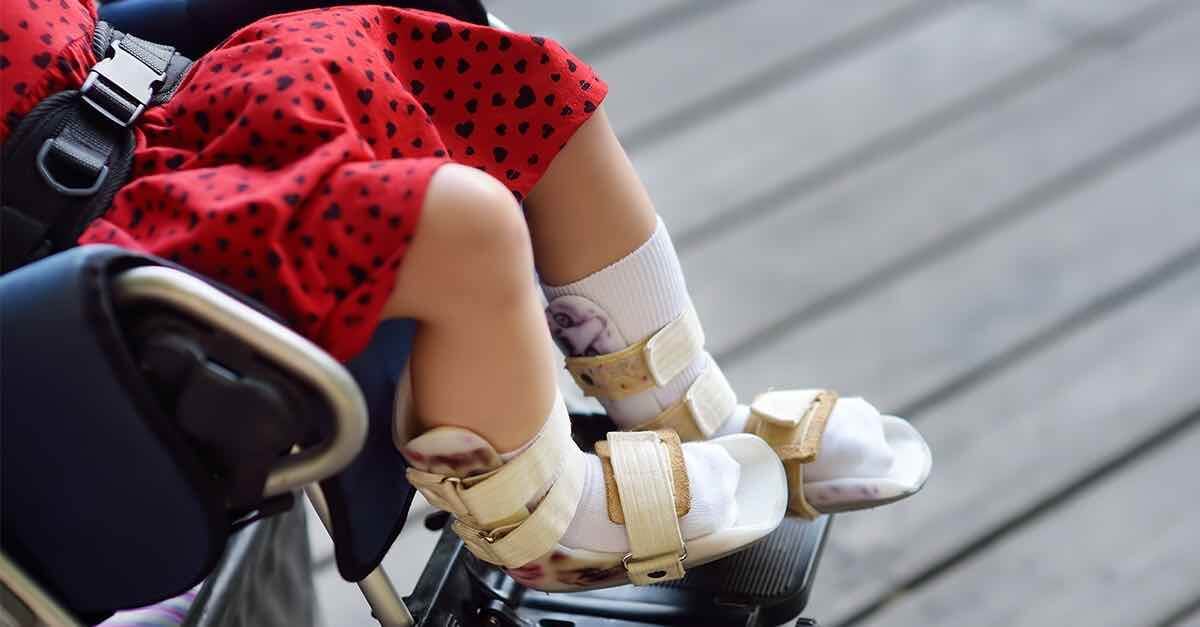Cerebral Palsy Foot Problems

Children with cerebral palsy may develop various musculoskeletal problems such as bone deformities, dislocated joints, and contracted muscles that lead to issues with the feet. In fact, cerebral palsy foot problems are the most common musculoskeletal problem in children with the condition. The type of cerebral palsy foot problems a child may develop can vary greatly and is often unpredictable before age five.
Foot Disorders Caused by Cerebral Palsy
The most common foot disorder to occur in children with cerebral palsy is called equinus deformity, which causes the foot to point downwards. This type of cerebral palsy foot problem is usually part of a larger issue in the lower extremities, which includes legs, ankles, and feet.
Other cerebral palsy foot problems include:
- Clubfoot: This occurs when the foot is severely turned in and upwards so that it faces sideways.
- Flat Feet: Low muscle tone in cerebral palsy can lead to flat feet, with either no arch or only a slight arch. When this is combined with impaired functioning of the lower extremities, it can also cause the foot to drag along the ground.
- High Arches: Muscle contracture can cause the feet to lack flexibility which creates a very high arch.
- Hip Dysplasia: Hip dysplasia occurs when a hip socket doesn’t cover the ball at the top of the thigh bone. This causes limited movement and a high risk of dislocation.
- Leg Length Difference: Differing leg length is another common problem caused by cerebral palsy. This difference can cause discomfort and lack of stability.
- Leg Torsion: Torsion is the twisting of the shinbone and thigh bone. If these bones twist abnormally (either inward or outward), walking becomes difficult.
- Muscle Contracture: A common symptom of cerebral palsy is overly-toned muscles. This can lead to a shortening of muscles that causes inflexibility and difficult movement.
- Toe Walking: Toe walking is caused by muscle contracture of the Achilles tendon. This can create discomfort when the heel is placed on the ground while walking.
Diagnosing Cerebral Palsy Foot Problems in Children
Promptly diagnosing foot problems is very important in order to get proper treatment. Cerebral palsy foot problems are diagnosed through several methods.
Methods to diagnose cerebral palsy foot problems include:
- Conducting Silfverskiöld tests (finds Gastrocnemius contractures) to check for Achilles problems
- Inspecting feet and lower extremities
- Performing range of motion tests
- Running imaging tests, such as radiographs
Motion analysis provides orthopedists with a better understanding of how to accurately diagnose cerebral palsy foot problems. This allows targeted treatment that may lead to significant improvement in function.
Treatment for Cerebral Palsy Foot Problems
Children under 5 years of age are generally treated nonsurgically. This may include spasticity treatment, such as botulinum toxin (Botox®) to relax tight muscles. While Botox injections can be highly effective, the benefits are temporary, so injections must be repeated.
Other common nonsurgical treatments for cerebral palsy foot problems include orthotic shoe inserts and manual therapy. Manual therapy is a form of physical therapy that includes kneading and manipulating muscles and joints.
Braces and casts may also be used to treat cerebral palsy foot problems. Casting has been found to be especially effective in clubfoot. The treatment involves a series of casts over several weeks until the foot position improves. Braces can be used to help prevent the clubfoot from returning once it is corrected.
Children become candidates for surgery between the ages of 6 and 10. Surgeries are usually designed to correct as many cerebral palsy foot problems as possible in one procedure.
Surgeries for cerebral palsy foot problems include:
- Bony Reconstruction: Bony reconstruction is designed to fix joint positioning, which can provide relief for abnormalities that make using braces difficult.
- Joint Fusion: Fusion of the joints can provide long-term support of the skeletal system for children with severe deformities.
- Muscle Lengthening: Muscle lengthening procedures are used to improve motion in the joints to help with walking. This type of surgery can also prevent future deformities.
- Tendon Transfers: This surgery entails parts of the muscles being transferred to different joint locations to improve balance.
Additional techniques to help manage muscle spasticity include nerve surgery and delivery of intrathecal Baclofen medication directly to the central nervous system.
Treatment options for cerebral palsy foot problems have improved drastically over the years due to extensive research on children with the condition. This has greatly improved the quality of life for children with cerebral palsy.
Learn More About Mobility Issues in Children With Cerebral Palsy
Mobility issues in children with cerebral palsy can be better managed with quality treatment. Having an orthopedic specialist on your child’s care team is important.
It is also critical to discuss your child’s specific issues as early as possible. Early and ongoing treatment can help prevent mobility problems from developing and getting worse.
To learn more about the mobility and support options that may be available to your child, download our free Cerebral Palsy Guide.
